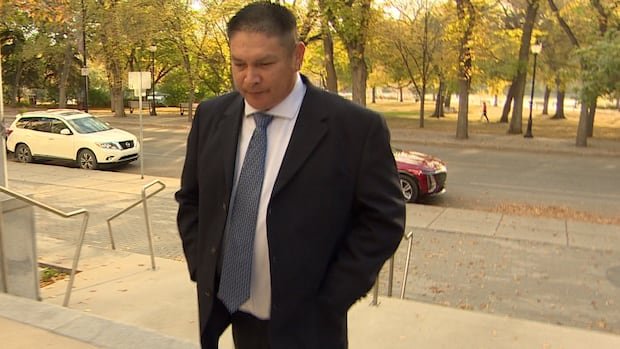The association representing 51,000 Alberta teachers who have been out of work since Oct. 6 says they have been asked to return to classrooms voluntarily and attend talks that did not consider limits on class sizes or student-teacher ratios.
As classes were canceled for a ninth day for about 750,000 students, Alberta Teachers Association president Jason Schilling said teachers rejected a request to attend “enhanced mediation” meetings that would prevent teachers from taking any job action for a month.
Schilling said the association would not participate in what he said was a biased process in favor of employers, adding that he found the proposal insulting.
“This is one of the driving factors that teachers have been pushing for,” Schilling said at a news conference Friday. “They’ve been talking about the fact that their classrooms are overcrowded, that they don’t have the resources to meet the needs of their students.”
At a news conference Friday afternoon, Premier Danielle Smith said Albertans should “fully expect” legislation to force teachers to return to work during the week of Oct. 27, should the parties fail to reach an agreement before the legislative session begins.
“We don’t want to affect kids’ ability to start planning where they’re going to go to college, and that starts to affect them as early as 11th grade because they can get early admission to college,” he said.
The ATA has not yet said whether it will challenge any return-to-work legislation in court.
A letter from the Finance Minister’s office on Thursday, published by the ATA, suggested the parties submit proposals to a mediator over teacher salaries and classroom complexity. The ATA removed all signatures from the letter before its publication.
Complexity refers to educators’ concerns about a growing number of students who need individual attention and help for needs such as learning English, behavioral challenges, physical or mental health conditions, or disabilities.
“By engaging in this process, we are directing the mediator to consider the diverse causes of these complexities and consider equally diverse solutions that could be implemented flexibly to respond to different needs, that are feasible within reasonable investments and resources, and that depend on a committed partnership of teachers and their employers,” the letter says.
“In any case, the mediator’s recommendations cannot set strict limits on classroom sizes or student-teacher ratios.”
The letter says the government assumes the ATA would prefer mediation over back-to-work legislation or a prolonged strike.
“As strong and free Albertans, we will not be intimidated or governed by threats that attempt to force us back to work and away from our principles,” Schilling said, alluding to a new provincial license plate motto unveiled Wednesday by the premier.
At the government’s news conference in Calgary on Friday, Education Minister Demetrios Nicolaides said he hears teachers’ concerns about class sizes and complexity and is willing to hire more teachers and school support staff and build schools to improve conditions.
Smith said mechanisms such as limits on class sizes and student-teacher ratios deprive school boards of staffing flexibility to respond to local needs.
“Unfortunately, the ATA is obsessed with a single solution, and that is part of the problem,” he said.
In an emailed response, Schilling said the prime minister is oversimplifying the issue.
“Our proposal contains a solution tailored to Alberta’s public education system, which builds on similar approaches that other provinces have had success with,” their statement read.
Professor: Back-to-work bill could cause long-term anger
Jason Foster, a professor of labor relations and human resources at Athabasca University, said the government’s invitation was clearly unpalatable to teachers and was more about optics than reaching an agreement.
Foster said he believes the details in the letter could foreshadow what the province includes in potential back-to-work legislation for teachers.
Such legislation would require teachers to return to their duties and would likely push the parties into binding arbitration, Foster said. The government can also determine what issues an arbitrator can and cannot address. He believes the government is likely to prevent an arbitrator from considering class sizes or student-teacher ratios.
Although teachers could defy such an order, rebellion could result in fines for the association and even for individual teachers, Foster said.
Educators could also refuse to participate in extracurricular activities if they are forced to return to work, he said, to encourage the public to pressure the government.
A back-to-work law does not resolve the conflict, Foster said, and will likely dump the problems on a future administration to resolve.
“We will have teachers in our schools who will be even angrier and feel even more disrespected by the government, and that will have long-term consequences,” he said.
November diploma exams optional.
Meanwhile, Alberta Education said Friday that it will be optional for any student scheduled to take a diploma exam in November to sit that exam.
A news release said the change was a result of the teachers’ contract dispute. The January diploma exams are scheduled to proceed as usual and will account for 30 percent of a student’s final grade in a diploma course required for graduation.
After rejecting two contract offers in five months, teachers working in all of Alberta’s public, Catholic and French-speaking schools left their jobs on October 6. Three days later, their employers shut them down.
Around 750,000 students are out of class.
Teachers are not paid or paid strike wages during the lockout.
Educators say they want bigger pay raises than employers have offered, to make up for a decade of relatively stagnant wages while costs rose substantially.
Most recently, employers had offered a 12 percent across-the-board pay increase over four years, with net adjustments in 2026 that would give some teachers additional raises.
Teachers also rejected a government offer to pay for 3,000 more teachers and 1,500 more educational assistants by 2028.
The ATA has said that without a student-teacher ratio or measures to address complexity, problematic classroom conditions will persist. The association has said that legal mechanisms that maintain reasonable classroom composition will protect students in perpetuity, and that time-limit promises to hire more staff will not.
Most Canadian provinces have a legal mechanism, in legislation or in teachers’ contracts, that limits class sizes and/or students with complex needs.
Jason Ellis, associate professor at the University of British Columbia’s faculty of education, shares how BC has handled classroom complexity in its teaching contracts and what to expect in Saskatchewan as teachers work to finalize theirs.
This week the Prime Minister has floated the idea of a “complexity cap” that would add more educational assistants to schools, or create a commission to study schools, as the Progressive Conservative government did in 2002 in response to the last widespread teachers’ strike.









